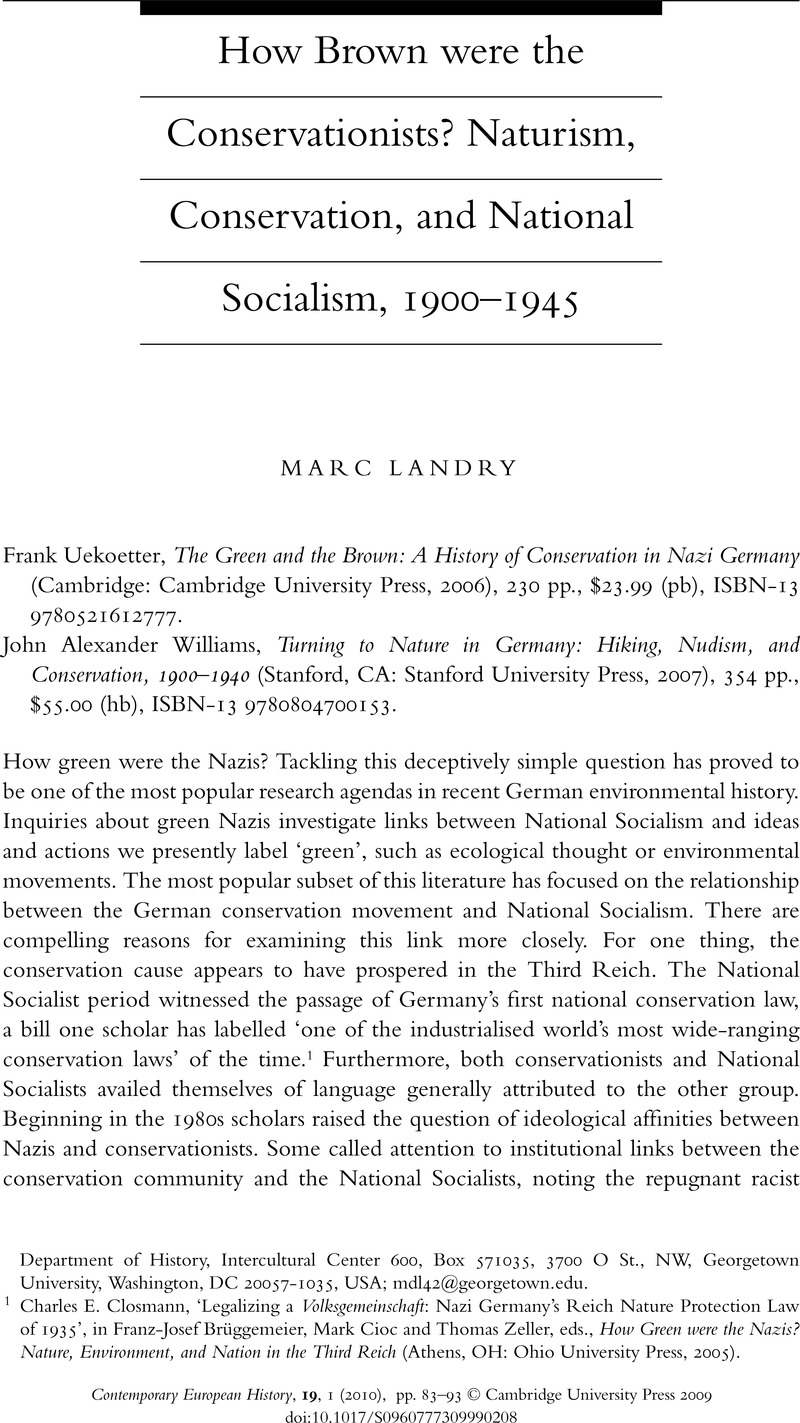No CrossRef data available.
Published online by Cambridge University Press: 16 December 2009

1 Closmann, Charles E., ‘Legalizing a Volksgemeinschaft: Nazi Germany's Reich Nature Protection Law of 1935’, in Brüggemeier, Franz-Josef, Cioc, Mark and Zeller, Thomas, eds., How Green were the Nazis? Nature, Environment, and Nation in the Third Reich (Athens, OH: Ohio University Press, 2005)Google Scholar.
2 See the two works by Gröning, Gert and Wolschke-Buhlman, Joachim: ‘Naturschutz und Ökologie im Nationalsozialismus’, Die Alte Stadt, 10 (1983), 1–17Google Scholar; and Die Liebe zur Landschaft. Teil III: Der Drang nach Osten. Zur Entwicklung der Landespflege im Nationalsozialismus und während des Zweiten Weltkrieges in den ‘eingegliederten Ostgebieten’, Arbeiten zur sozialwissenschaftlich orientierten Freiraumplanung 9 (Munich: Minerva-Publ., 1987).
3 Bramwell, Anna, Blood and Soil: Walther Darré and Hitler's Green Party (Bourne End: Kensal, 1985)Google Scholar.
4 Stern, Fritz, The Politics of Cultural Despair: A Study in the Rise of Germanic Ideology (Berkeley: University of California Press, 1961)Google Scholar; Mosse, George, The Crisis of German Ideology (New York: Grosset & Dunlap, 1964)Google Scholar; Bergmann, Klaus, Agrarromantik und Großstadtfeindschaft (Meisenheim: 1970)Google Scholar.
5 One important example is Alwin Seifert, a former Rambler and the most important landscape architect of the Nazi Autobahn project. See Zeller, Thomas, Driving Germany: The Landscape of the German Autobahn, 1930–1970 (New York: Berghahn, 2007), 31–33Google Scholar.
6 Dahrendorf, Ralf, Gesellschaft und Demokratie in Deutschland (Munich: Piper, 1965)Google Scholar; Schoenbaum, David, Hitler's Social Revolution: Class and Status in Nazi Germany, 1933–1939 (Garden City, NY: Doubleday, 1966)Google Scholar; Herf, Jeffrey, Reactionary Modernism: Technology, Culture, and Politics in Weimar and the Third Reich (Cambridge: Cambridge University Press, 1984)Google Scholar.
7 Examples of this more recent literature are Dominick, Raymond, The Environmental Movement in Germany: Prophets and Pioneers, 1871–1971 (Bloomington: Indiana University Press, 1992)Google Scholar; Knaut, Andreas, Zurück zur Natur! Die Wurzeln der Ökologiebewegung (Greven: Kilda, 1993)Google Scholar; Rollins, William, A Greener Vision of Home: Cultural Politics and Environmental Reform in the German Heimatschutz Movement, 1904–1918 (Ann Arbor: University of Michigan Press, 1998)Google Scholar; Schmoll, Friedemann, Erinnerungen an die Natur: Die Geschichte des Naturschutzes im dentschen Kaiserreich (Frankfurt: Campus, 2004)Google Scholar; Lekan, Thomas, Imagining the Nation in Nature: Landscape Preservation and German Identity, 1885–1945 (Cambridge, MA: Harvard University Press, 2004)Google Scholar; Brüggemeier et al., How Green Were the Nazis?; Willi Oberkrome, Nationale Konzeptionen und regionale Praxis von Naturschutz, Landschaftsgestaltung, und Kulturpolitik in Westfalen-Lippe und Thüringen (1900–1960) (Paderborn: Schöningh, 2004).
8 The results of this conference were published in Joachim Radkau and Frank Uekötter, eds., Naturschutz und Nationalsozialismus (Frankfurt: Campus, 2003).
9 This formulation comes from an influential work of US environmental history: Cronon, William, Changes in the Land: Indians, Colonists, and the Ecology of New England (New York: Hill & Wang, 1983)Google Scholar.
10 A point of contention between the authors concerns the shift in conservationist discourse towards the end of the Weimar period that Williams believes represents a partial convergence with National Socialist ideology (p. 319 n. 70).
11 Sievert, James, The Origins of Nature Conservation in Italy (Bern: Peter Lang, 2000)Google Scholar.